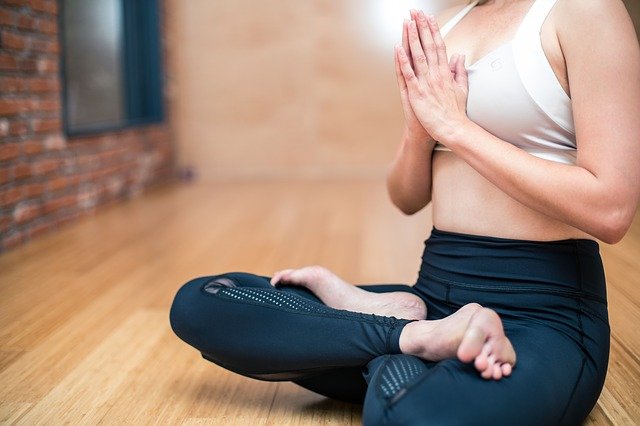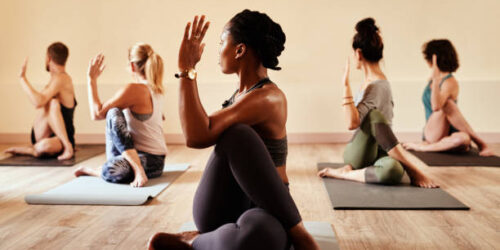How To Use Yoga Wheel? 10 Easy Exercises For Beginners
First, how to use the yoga wheel?
Wheel-assisted child pose, tilt easy pose, fish pose, up facing pole pose, chiropractic massage, movement, open shoulder stretch, developing core strength, chest, back, and spine extension are some of the poses that can be performed with the help of a wheel.
Invented in the last decade, yoga wheels are a novel, adaptable yoga accessory. Depending on your primary objective or purpose for using it, they come in a variety of sizes. However, did you know that yoga wheels also provide a wealth of physical advantages?
I’ll give you more thorough instructions on how to use the yoga wheel.
Table of Contents
How To Use Yoga Wheel?
Wheel-assisted Child’s Pose
In addition to gently stretching the hips, thighs, and low back, Child’s Pose also gives your shoulders and chest a nice stretch when you use a yoga wheel and extend your arms forward on top of the raised surface of the wheel.
- Sit back on your heels while knelt on the ground with your big toes in contact. Place the yoga wheel between your knees with your legs at least hip distance apart.
- Put your hands up on the wheel. Breathe in, then as you exhale, tilt your torso forward and lengthen your spine while using your hands to move the wheel away from your body.
- Lean forward further until your arms are straight in front of you and your belly is comfortably resting between your thighs. As your chest and shoulders experience a deeper stretch, try to rest your forehead on your mat while letting your head and neck relax.
- A minimum of three breaths should be held.
Reclining Easy Pose
Easy Pose is a traditional cross-legged seated position that promotes mental fortitude and steady breathing. A controlled chest-opening backbend is included in the version done while reclined with the help of the yoga wheel to help release shoulder tension.
- Place your spine parallel to the yoga wheel as you sit up straight. To feel grounded to the floor, cross your legs in a comfortable manner.
- Close your eyes and place your hands palms up on your knees.
- Take a deep breath in and, using your exhalation to support your backbend, slowly extend your spine over the top of the wheel. The top of the yoga wheel should be where your head’s back rests.
- At least five deep breaths should be taken while sitting in this position, but you should only remain in the pose for as long as it is comfortable for you.
Wheel-assisted Fish Pose
Fish Pose is a fantastic backbend pose that opens the chest and stretches the pectoral and shoulder muscles3. However, some people can’t hold the standard pose on their own, while others would prefer a deeper stretch. A solution for both groups is offered by the yoga wheel.
- With your legs out in front of you, sit upright on the floor. Your inner thighs should be squeezed together while you internally rotate your hips and point your toes.
- Put the yoga wheel directly behind your back, parallel to your spine, and hold it there with your hands.
- Inhale deeply, then, as you exhale, bend backward, extending your spine over the top of the wheel. Let go of your hands so that the wheel can bend with your body.
- Increase the pose’s depth by lifting your hips and allowing the wheel to support and massage the area of your spine between your shoulder blades. Leaning against the steering wheel, loosen up your neck and head. Put your arms in a position that feels natural to you and promotes balance by spreading them widely.
- Before turning around to sit down on your mat, hold for at least three breaths.
If you find it too challenging to maintain balance in this position, you can modify the exercise by bending your knees and putting your feet flat on the floor, hip-distance apart.

Wheel-assisted Upward-facing Two-foot Staff Pose
For yogis working toward more advanced backbends, such as Wheel Pose, King Pigeon Pose, or even an unassisted Upward-Facing Two-Foot Staff Pose, the yoga wheel offers a significant assist.
You can move into positions you might not feel comfortable attempting without the additional support along your spine or in the area between your shoulder blades by using the wheel to support your backbend. By doing so, you can increase your self-assurance and muscular strength in the areas that are actively used, which will eventually move you closer to your objectives.
- To position the yoga wheel so that it is parallel to and in line with your spine, sit tall with your knees bent and your feet flat on the floor. To hold the wheel in place, lightly press your hands against its interior.
- Lean back against the steering wheel while releasing your hands. As you exhale, press through your heels to lift your hips and raise your arms over your head with bent elbows pointing straight back.
- Keep extending your spine over the top of the wheel until it rolls between your shoulder blades. Try to place your forearms flat on the mat as soon as your arms touch the floor. Then, grasp the wheel firmly with both hands to keep it in place. Put your neck and head at ease while driving. To keep your knees in line with your toes, contract your inner thighs.
- Keep your inner thighs and feet engaged to prevent your hips and knees from externally rotating. If you’re comfortable, you can extend one leg at a time for a deeper stretch of your quads and hip flexors.
- Hold the position for three to five breaths, then slowly turn around to release the pose.
Spinal Massage And Mobility
Using a yoga wheel will help your spine! Have you ever supported your heart opener by placing a block or bolster beneath your spine? Take that wonderful sensation and multiply it with a round yoga wheel that can follow the curves of your spine.
By rolling the wheel up and down the length of your spinal column, you can massage your spine as an added bonus of movement. Alternatively, if a backbend is what you’re after, find a static hold with the wheel under your upper/middle back. A great way to combat the harmful effects of our sedentary lifestyle is with this stretch.
Bring the yoga wheel to the base of your spine while sitting and keep your feet firmly planted as you start to roll your spine up and onto the wheel. From this point, you can experiment with gradually rolling forward and backward to experience the full benefits of a spinal massage.
Stretch & Lengthen Full Body
The foundation for other uses can also be built upon the same position that was used in number 1. Roll the wheel onto your upper spine at that point, and then reach your hands up and back to grab hold of the wheel behind your head. This is a fantastic way to loosen up the upper back, neck, and head as well as stretch and open the shoulders.
In order to focus on particular body parts, you can also try a variety of different yoga poses:
Low Lunge with the wheel either beneath the front thigh for a supported hamstring stretch, or supporting the lifted back shin for a quad stretch.
Reclining Butterfly Pose is a gentle hip opener, and the effects are amplified using the wheel to experience a nice heart opening backbend. Bring your feet’s soles together while sitting. Lay back on the yoga wheel after bringing it to your low back. Palms facing up, place your arms by your sides.
Reclining Hero Pose is a deeper way to open the front body, find a backbend, and stretch into the quads, knees, and ankles. Bring your knees to hip-width apart (you can spread them wider for a kinder pose or closer together for a deeper one). Roll your spine onto the steering wheel and extend your arms above your head as you lower your seat so that it is between your heels.
Strengthen And Tone Full Body
Using your yoga wheel to move can be a lot of fun and a great way to tone and strengthen your entire body. You can concentrate on the upper or lower body as a whole, or you can target particular body parts, such as the core, glutes, and legs. There are many options, but we’ll focus on some of the most important ones here:
Core and upper body can be targeted simultaneously when you come into a modified Shins on the yoga wheel in plank position. Simply move your body into a pike-like position and then roll the wheel back into full plank as you move forward. Repeat to develop abs, arms, and chest strength and tone.
Glutes and lower body can also be targeted with a yoga wheel. Step your left foot longways onto the wheel while still standing, bringing the wheel to face your right inner ankle. Bend into the front knee and maintain a straight spine as you roll it away from your ankle. By doing this, you’ll build stronger glutes, quads, calves, and ankles.
Open Shoulders Extended
This stretch works the back and shoulders well and is excellent for beginners.
Many of us spend a lot of time rounding our shoulders and closing our chests. Think about how your body would appear while you were driving, using a computer, eating, or a smartphone.
We are occupied with these daily activities for such a long period of time that we are oblivious to the passing of time while we are in these positions. This pose is great for releasing all the shoulder and back tension we accumulate throughout the day. This position will help you posture, back flexibility, and shoulder joint range of motion.
Build Core Strength
Here is another beginner’s pose that emphasizes stretching as well as strength development.
A solid yoga practice requires a strong core. Like in the previous pose, regular core strengthening will help reduce back pain and give your body the stability it needs to perform more difficult yoga forms and poses. You can intensify the “planking” pose and get a more intense core workout with the aid of your yoga wheel.
Chest, Back & Spine Extension
A great beginner stretch that should only be attempted if your back and shoulders are in good shape is the Chest, Back & Spine Extension stretch.
Before performing more challenging backbends, this pose is ideal for warming up your back. A safe way to improve your backbends and stretch out your back is by using your wheel as support. Backbends are heart-opening poses.
Read about: How To Stroke A Man’s Ego?
FAQs About How To Use Yoga Wheel
What Are The Advantages Of The Yoga Wheel And Does It Have Any Merit?
Yoga flow exercises the body and mind while fostering an unbreakable sense of intense concentration. Whether you are a beginner or an experienced yogi, a renowned US yoga instructor created a prop that is sure to strengthen your yoga practice. Ever since its launch, the yoga wheel has been catching on across the world.
What Size Are Yoga Wheels, And How Much Weight Can They Support??
The roller is able to support up to 500 pounds and is available in small, medium, and large sizes. Small wheels are used to massage specific body parts, medium wheels are better for toning exercises, and widest wheels are ideal for improving balance. It is a very practical prop to carry around when switching between studios because it weighs only 4 pounds.
Does Yoga Wheel Relieve Back Pain?
Users have discovered that it is not only aesthetically pleasing but also very helpful for correcting posture and easing back pain issues. Resting on the yoga wheel while massaging the back was proven to release the pressure off the spine, improving the posture.
What Is A Yoga Wheel Used For?
The yoga wheel comes in gorgeous materials and designs, that were made to help you get deeper into the asanas more quickly and safely.
Conclusion
The yoga wheel’s use was the main topic of the article.
The variety of applications for yoga wheels may be one of their appeals. A yoga wheel can help you increase your flexibility, mobility, strength, and stability, making it the ideal addition to any other fitness routine you might have.
Regarding your reading, I thank you.





